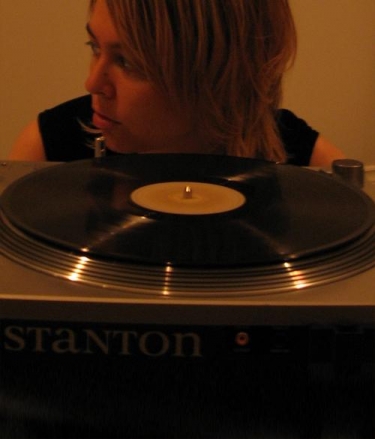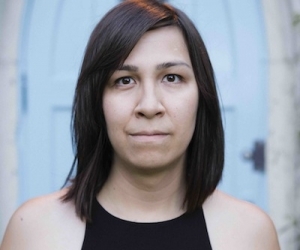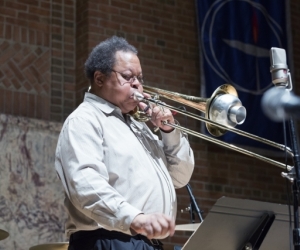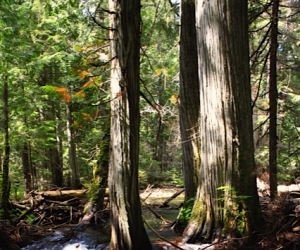
Nicole Lizée is a huge fan of Alfred Hitchcock, science-fiction films, and Lars von Trier, the maverick Danish director whose Dogme (dogma), about film, inspires her own reflection on how to compose music. She says composers should be just as bold and inventive about creating music as von Trier is about making films. The director, who describes his life as a fabrication, has provoked a new current in cinema with his unstable camera work and raw observations of human nature.
At the age of eleven, Lizée made multiple recordings of her voice, using a series of ghetto blasters, replaying and layering the tracks for effect in a homemade montage. She recalls that “There would be hiss and warping, and the first track would recede into the background with an odd timbre.” Traces of these early experiments remain evident in her current creations. The garbled tape sound on an early-edition Jesus of Nazareth video-disc of the miniseries inspired an interest in glitch and the fallibility of media. “Things can fail in spectacular ways,” she observes, “and provoke interesting visuals and sound. “Glitch, noise, hum, static, warping—I’m very drawn to these sounds. I use them to a large extent in my purely acoustic works. They’ve become idiomatic.”
Nicole Lizée, in her mid-thirties, from Gravelbourg, Saskatchewan, studied piano in Brandon, Manitoba, and composition at McGill University. She has played with a series of different indie rock bands and now she writes concert music from her home in the Montreal suburb of Lachine.
She grew up in a house full of electronics, during the time when cathode ray tubes, resistors, capacitors, and solid-state wiring were heading for extinction. She listened to an impressive collection of easy-listening and light-classical albums at home and watched the first MTV videos. “It was nothing like I had ever seen or heard before. I couldn’t look away.”
After her first decade writing music, her composition list includes thirty pieces. Her bio notes an already impressive number of commissions, collaborations, nominations, and awards. At <www.nicolelizee.com> a television is pictured with colour bars shimmering, an empty rocking chair seems to beckon to a viewer; flowered wallpaper and a girl’s portrait in shadow decorate the wall. This Will Not be Televised reads the title of her site. It is also the title of an important composition in her body of work.
Her work with turntables and DJs is singular, employing them to produce a precise sound at an exact moment, as would be done with any other instrument in ensemble playing. It is not random. In addition to this and the use of standard instruments, she has composed with a surprising array of sound sources. An overview of her work finds samples extracted from late ’70s to ’80s arcade games (Arcadiac, 2005–08); a consideration of the “effect and feelings evoked in films and their soundtracks” (Dystopia Suite, 2009); and ’50s and ’60s science-fiction films (King Kong and Fay Wray, 2004, and Left Brain / Right Brain, 2002). She has deconstructed an interpretation of the Post-Punk and Art-Punk movements in Vertigo Beach (2007), a solo piano piece commissioned by Montreal musician Brigitte Poulin.
Subversion and transformation
Lizée’s affinity for film offers an insight into her imaginative sub-terrain, for it provides inspiration, visuals, and aesthetic stimulus for her creations. The films of Hitchcock and those in the science fiction genres impress her with their craft and unpredictability, and their inventive power in convincingly portraying the purely unreal with sound and image. Hitchcock’s singularity as a distinctive auteur is a model for Nicole Lizée. His films furnish iconographic inspiration and set the stage for her anachronistic manipulations. Like him, she will, she says, “use the same material in several different pieces—maybe different instrumentation, maybe change the tempo, the harmony. Or sometimes I’ll keep it exactly the same, but the surroundings or context [will be] different, which ultimately colours the perspective.”
Re-contextualization is the term she prefers for describing a broad view of her composing procedures. She also uses the words environments and surroundings to discuss how she organizes materials and relates them to her intentions, commenting further that decontextualization, deconstruction, and reconstruction all describe her approach to composition. “The subversion and blurring and melding of genres have been major components in my artistic practice. I grew up immersed in many music genres and styles. They are all intertwined and filtered in my own musical language.”
The question of contexts in the practice of experimental music raises the question of how to consider the multiplicity of approaches, aesthetics, and definitions currently in circulation. The attempt to classify those practices within approximate categories of genres and subgenres is a common and prickly issue in the chronicling of contemporary Western culture. Artistic exploration leads to a corresponding effort, often through the process of comparison and classification, in establishing relationships to tradition.
Nicole Lizée possesses exceptional clarity of intention. Reading her composer’s notes and listening to the tracks of her music leave no doubt about her intentions, procedures, or materials. Similarly, she is succinct about her sources of influence and inspiration: “The late 1970s to mid 1980s—my formative years—was a time of particular sonic diversity and innovation. Synthetic sounds had begun to seep into the collective consciousness. The experimentation and inventiveness that took place during this period, particularly in the areas of music and technology, influence me tremendously. The contexts in which I incorporate them continue to evolve and develop. I’m always conscious about the way they shape or impact my music or the way my music twists or contorts the influence, so much so that the source essentially loses its original function and becomes something completely different within the frame of the new work.” This is key to understanding Lizée’s procedures. Examples of this kind of subversion and transformation of materials are evident in the samples from Van Halen she uses in This Will Not Be Televised (2005-2007) or the karaoke material in Karappo Okesutura (2006).
The idea of linking Lizée’s work to a specific geographical influence such as the Canadian Prairies, is, according to her, unrevealing. Still, everyone comes from a time and a place and as such, “the fact of a small town, an electronics repairman’s daughter, all provided context,” she admits. She also recognizes that there are situations that she necessarily responds to—for example, a commission or festival programming. “The programmer uses frames to justify and promote events or to link things together. A composer doesn’t think of that too much in the composing process. If I’m given a theme for an event, I find my own ways to connect it all. It will happen on its own, and I don’t know if an artist can control that, since it often happens after the fact.”
She possesses a keen intuition about making things fit. Awkwardness, obscurity, and isolation are absent in the collection of pieces available for listening on her Web site and on her 2008 Canadian Music Centre Centrediscs CD. So far, the diversity, innovation, and creative intuition all work. Scoring for a DJ turntable solo onstage next to the first violin is an example of how she both crosses lines and creates within tradition. “Conductors and orchestras have been very open to working with it and making the required adjustments because I treat it as an instrument exactly like the others.” Some adaptation is necessary so that the directives and expectations can fit. There are also logistics to consider. “You have to treat it a certain way. Tempi, for example have to be modified because of the nature of the instruments. Raising the tone means making the turntable go quicker and thus the rest of the orchestra has to adapt to it.”
The net effect of hearing Lizée’s music, live or on record, is of an uncanny freshness, lucidity, and distinct personality. It is suave in its seduction, alertly suggestive of many worlds, and yet still speaks from only one world, Lizée’s. It’s soulful, and beyond the bright ease with which its forms and sensations unravel, it connects to weighted emotion and her savvy considerations. Girl, You’re Living a Life of Crime is a mesmerizing tune that, from its initial driving hi-hat riff, weaves a hypnotic pattern around the listener, which Lizée then develops by looping, splicing, and needle-skipping the pop-like melody. You want to hear it again and again. It’s not surprising that response was positive even to her first compositions, such as the string quartet she wrote as an undergraduate. Her thesis piece RPM (1999, revised 2005), which incorporated turntable, received similar immediate and strong recognition, and sparked further exploration with the instrument. In the 2005 revision she expanded two sections of the piece and strengthened the ensemble writing.
Though singular in her focused, intentional approach to composition and manipulation of materials, Lizée composes adroitly in and with many environments, and as such her work is diverse. If there is a single notion that might capture the context for viewing her work, it is time: historical, metered, and anachronistic. She filters through icons of the past, makes selections, and recasts them in new surroundings. She skews rhythm and twists tempo in surprising fashions, inviting the listener to attend to the notions of forwards and backwards. Like her cinema mentors Hitchcock and von Trier, she does not escape time, but discovers and hones her own ways of manipulating it, inviting us to hear it her way.
Make it (re)new
“The artist is always beginning,” Ezra Pound wrote in his seminal 1934 essay on modernism, “Make it New.” “Any work of art which is not a beginning, an invention, a discovery, is of little worth.” This declaration can be interpreted as part of the fissure in the aesthetic continuity that sends us seeking illumination about contexts sixty-five years later. Pound, an early twentieth-century literary Lars von Trier, a wild man, a brilliant innovator, and a controversial figure, speaks to us across the millennium break in his brittle voice. Heady with the fumes of their creative power, Pound’s modernists and their kids, the postmodernists, created abundantly, stuffing the twentieth century with an overwhelming production of objets d’art and ideas about themselves and their time. Along comes the twenty-first century, gasping for air, overwhelmed by the crowd—the music lover asking, ‘So what do you call this?’ By filling up space, you create a void. By reconsidering existing materials you make space. Maybe this sharpens the picture on Lizée, the twenty-first-century composer. Perhaps the aesthetic world is so cluttered with frames, ideas, inventions, and aesthetic positions that she and others of her generation recycle sonic elements, making them (re)new as Ezra Pound might insist. Generation X’s way of staking territory. This is not to subtract from the inventiveness or originality of Lizée’s process of re-contextualizing sounds to create new ideas. “The surroundings for these found elements are new. They are my language. It’s a lot of work to write a piece. Why would you write one that has already been written?”
Take as an example Lizée’s 2007 Vertigo Beach, dedicated to Tom Verlaine, composer, guitarist, and lyricist, best known as a front man for the New York rock band Television. In the fifteen-minute solo piano piece, the composer, seeking to interpret the Post-Punk and Art-Punk movement that took place in New York City from 1977 to 1984, structures her acoustic reinterpretation of the genre as a series of études. No amps, just one acoustic piano and ten fingers. “It’s my distorted interpretation of a genre,” explains Lizée, “and the materials that make up the work are my own. One idea gradually unfolds into the next, emphasizing the qualities that distinguish the genre to the point of exploitation.” From the haunting and sparse opening to its hard-driving and full-chord finish, Vertigo Beach relentlessly dashes through low-register metric modulations, the weaving in and out of streams of material, unexpected shifts of character, and tempo variation which she uses for colour. “Showcase the grit and dirty it up with the pedal,” she says. Her tour de force is an iteration of the music movements she refers to and yet is something completely different: a Vertigo Beach.
Depth and surface
She knows the trick of making her music very accessible while unfolding an uncompromising complexity and richness. She has the tune and a vision of the world that it sings about. “An artist,” she declares, “should be able to talk about what they do, even if only in their own words.” Nicole Lizée likes discussing semiotics and the displacement of a music icon with historic reference where it’s not expected. “Certain sounds have become iconic to me, and I want to capture and manipulate these icons within a particular framework.” The Atari piece, Arcadiac (2005–2008), is a work for computer-game music and orchestra. The musical material grows from the pitch in the video game, a dead icon. “Take something with a precise and identifiable meaning and connotations,” says Lizée, “and place it in different surroundings from its natural one.” Someone in the audience recognizing the reference and making a new connection to their memory of the game via contemporary music is in the bull’s-eye of her intention. Imagining the original emotional connection to the sound is part of the charge that she seeks, if not also an element of neatly hidden nostalgia.
“The only way to capture this very particular sound,” Lizée believes, “is to go straight to the source. I want to manipulate this specific colour within a new sonic environment or context, to twist and distort the sonority and subvert it within the live ensemble. The ensemble will take it over and engulf it in a new surrounding. This also applies to the inverse scenario—the presence of the pre-recorded fragment will bend and twist the perspective of the live material. It’s about destabilization at both extremes.”
Is sampling stealing? she asks. It’s not a new question. But for Lizée, re-contextualization adds new meaning and identity to the original elements. She sees them all as materials available to her compositional ear: colours, sound sources, instruments. And what about the Karaoke tapes, the records, and the DJ? Are these sources somehow fresher? “They are both freer and more bound,” she says, “because of their connotations, and because they are more recent than traditional instruments; but I want to find my own way with all this. I knew what I didn’t want to do with turntables: definitely not as a novelty. The idea was to take it out of its context and find what was possible.”
Following a recent performance of her work at a festival in New York, Nicole Lizée was referred to as a “surrealist collagist.” The tag suits her more than any other. Time, that whimsical observer, will eventually attempt to name and group this creative vision.
“I write experimental or concert music, but that doesn’t mean much. Whatever it is, I have to have a strong connection to the project and the materials.” In all new work, for Lizée, the challenge is how to convey the sense of music that possesses other technology, extending the extra-musical ideas into experimental music using just the purest and simplest instruments.
The variety of music worlds in which she works are complicit zones rather than conflicting ones. While challenging the formal contexts in which her pieces are played (club, concert hall, festival venues), she views it all as broadening possibilities rather than as acts of rebellion. DJs approach her and so do classical conductors like Yannick Nézet-Séguin. Her use of the turntable in orchestral work is an example of new technologies used for traditional purposes, re-situating a contemporary icon in an anomalous environment and creating extended techniques to establish the sound and create the effect she wants. She insists on the live element. “The turntable, treated as an instrument, needs a turntablist to control it, as with any traditional instrument. The turntablist follows the conductor—pushing, pulling, and manipulating the record according to his specifications. Dynamics, gesture, timing, feel, etc.—these are all performed by the turntablist in the same way they are performed by a violinist. So to tape the turntablist would be the same as taping a violin soloist. You need the attack and execution.”
Nicole Lizée’s music fits in the ear newly and very neatly. Its startling personality, broad scope, and pungent mix of iconic elements trick you into familiarity then lead you off on a seductive adventure. Close listening will reveal many worlds, some with shards of familiarity, but she seems to be singing for us in a region of her own devises, leaving the door wide open for our immediate pleasure and for memory. The only real mystery is where she will take us next.
Audio: Arcadiac (Excerpt, 2005–2007). Composed by Nicole Lizée. Performed by the Winnipeg Symphony Orchestra, Alexander Mickelthwate, conductor. Image: Nicole Lizée. Image by: Steve Raegele.


